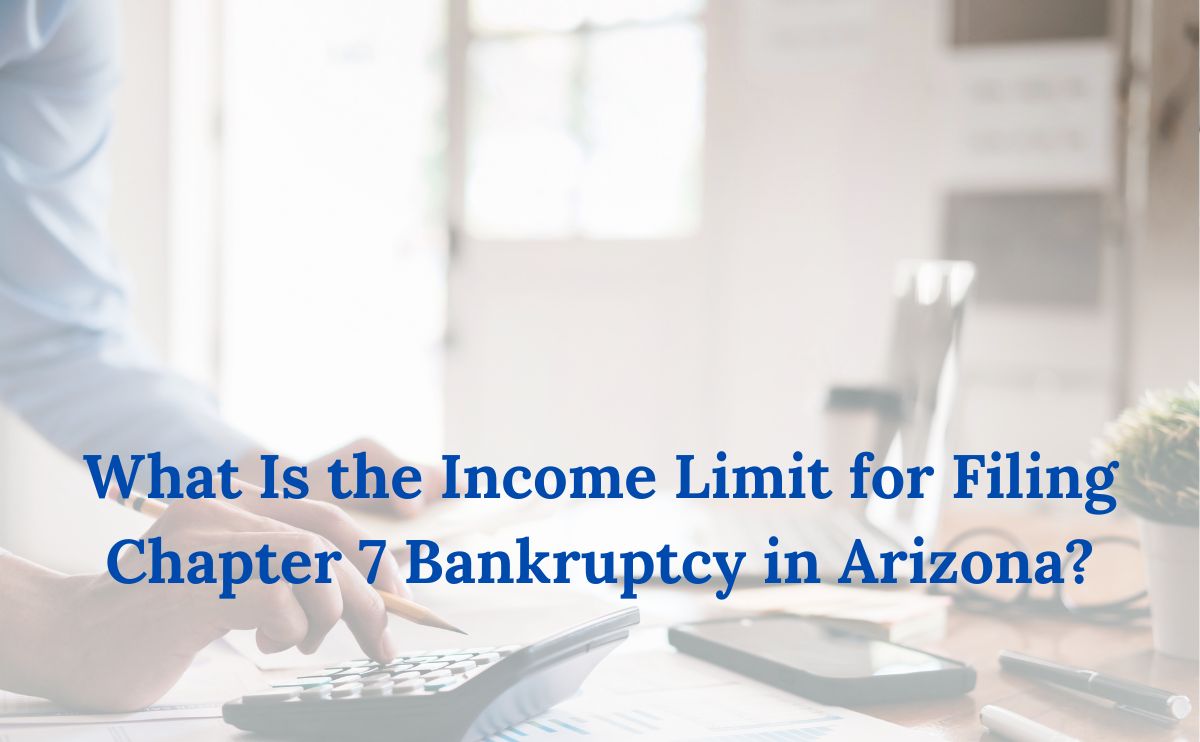Free Consultation
To discuss your financial situation and learn more about your debt relief options, give us a call at (520) 745-4429 or (480) 788-0098.
 Tucson(520) 745-4429
Tucson(520) 745-4429
 Mesa/Phoenix (480) 788-0098
Mesa/Phoenix (480) 788-0098

At Yusufov Law Firm PLLC, we focus on solutions that help folks in Arizona eliminate or reduce overwhelming debts. Our goal in this article is to share a user-friendly look at the income limits for Chapter 7 bankruptcy so you can be better informed.
If you suspect that this relief option might fit your situation, we welcome you to reach out for further help in checking your eligibility.
The Chapter 7 means test is a tool used to gauge whether filing a Chapter 7 bankruptcy would be unfair under bankruptcy law. This test was introduced in the Bankruptcy Abuse Prevention and Consumer Protection Act of 2005. In basic terms, the means test tallies your average monthly income and compares it against standard expenses to see if Chapter 7 is acceptable or if you likely have enough disposable income to repay debts under another bankruptcy chapter.
In Arizona, a major step is assessing whether your current monthly income is below the state median for a household of your size. If it is, you normally pass the means test, which means you can file for Chapter 7 without satisfying any additional income and expense requirements. If your income is higher, the analysis shifts to allowable expenses, which we will discuss further below.
The most recent data from the United States Trustee Program offers guidelines for Arizona households. These figures change periodically, and the table below reflects an approximate snapshot for households filing after April 1, 2025. Check the Trustee’s office for updates, as these numbers can shift over time.
Arizona Median Income for Chapter 7 (Approx.)
In Arizona, for Chapter 7 petitions filed after May 15, 2025, the income limits are:
| Household Size | Annual Income Limit |
| 1 | $70,919 |
| 2 | $85,476 |
| 3 | $102,909 |
| 4 | $113,286 |
| Each additional after 4 | Add $11,100 per person |
Your total monthly income is usually calculated by taking what you earned in the six months before filing, summing it up, and then dividing by six for a monthly average. That figure is multiplied by 12 to get the annual amount. If the annual number is below the income limit for your household size, you qualify for Chapter 7 bankruptcy. If not, you continue with the means test to see how monthly costs might lower your disposable income enough to help you qualify.
It may look as if all money inflows are counted, but some forms of income are left out. That’s one reason a thorough review helps. The means test requires that you total many types of financial inflows, such as:
Other types of compensation might be excluded. Income from certain benefit programs, social security disability payments, or selected war-related compensation can be left out. It’s crucial to examine each inflow carefully and see which class it falls into.
A family whose earnings top the median limit can still pursue Chapter 7 relief. The law lets you deduct approved expenses from your total monthly income to figure out whether you have leftover funds (sometimes called “disposable income”). If that leftover is below a certain threshold, you qualify for Chapter 7. There are many approved deductions, but the most common are the following:
In addition, when determining your eligibility for Chapter 7 bankruptcy, you can deduct specific living expenses from your income as part of the means test. These deductions, known as Allowable Living Expenses, are not based on your actual spending but on standardized amounts set by the IRS and the U.S. Trustee Program. This system ensures fairness and consistency for everyone filing.
These expenses are divided into two main categories: National Standards and Local Standards.
National Standards cover essential, everyday necessities where costs don’t drastically change from one part of the country to another. These figures provide a uniform baseline for what is considered a reasonable monthly expense for basic needs, regardless of where you live.
This category includes allowances for:
The data for these standards is compiled from nationwide statistical surveys, such as the U.S. Bureau of Labor Statistics Consumer Expenditure Survey, to reflect average spending habits.
Local Standards account for expenses that vary significantly depending on your geographic location. The government recognizes that the cost of housing and transportation in rural Arizona is very different from that in a major city like Phoenix.
These standards are based on your specific county or metropolitan area and primarily cover:
By using both national and local standards, the means test creates a realistic budget to accurately assess your “disposable income”, the money left over after essential expenses, and determine if you have the ability to repay your creditors.
Some people find themselves with too much disposable income after deductions. That doesn’t end your quest for debt relief. Other avenues may help:
If you’re balancing multiple obligations, one or more of these strategies may help you seek relief. Chapter 13, for instance, may allow you to eliminate part of your debt while spreading out payments on the remainder over time.
At Yusufov Law Firm, we have been helping individuals navigate the bankruptcy process for over fifteen years. You can reach us in Tucson at (520) 745-4429 or in Mesa/Phoenix at (480) 788-0098, or Contact Us online to schedule a consultation. We look forward to helping you explore a path to financial peace of mind.
To discuss your financial situation and learn more about your debt relief options, give us a call at (520) 745-4429 or (480) 788-0098.
© 2010-2025 Yusufov Law Firm PLLC. All Rights Reserved | Disclaimer | Sitemap |